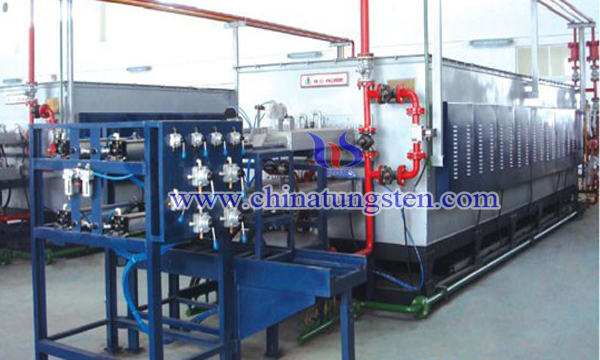Particle Size Change Mechanism of Ultrafine Tungsten Powder
- Details
- Category: Tungsten Information
- Published on Tuesday, 01 August 2017 10:07
In the reduction process, the particle size of tungsten oxide will usually change. Most of Chinese scholars believe that there are two main mechanisms for the change of particle size in the reduction process.
They are the mechanism of chemical vapor transfer and the reaction mechanism of localized solid phase characters, and these two mechanisms can be taken into consideration in the preparation of superfine tungsten powder.

1, Growth mechanism of chemical vapor transfer: when tungsten and its oxides are in contact with water vapor, a volatile hydrated tungsten oxide WO2(OH)2 is formed and is volatilized to the gas phase to undergo a homogeneous reduction reaction with H2. The reduction products are deposited on nucleated tungsten grains, thus increasing the size of tungsten particles. The reaction rate is fast, and the morphology of reduction products will change significantly compared with that of raw materials.
2, Chemical reaction mechanism of solid phase: the solid tungsten oxides react with H2, resulting a gas-solid reaction. And the lattice rearrangement undergoes with the removal of oxygen atoms. The reaction rate is slow, and the shape of the reduction products doesn’t change.
The above two mechanisms both exist in the reduction process of tungsten powder. And dominant position is decided mainly by the temperature and water content in the atmosphere. The key to prepare ultrafine tungsten powders is reducing the formation of volatile hydrated tungsten oxide WO2(OH)2 and inhibiting the process of chemical vapor migration. Under certain temperature, the equilibrium partial pressure of WO2(OH)2 mainly depends on hydrogen humidity. The greater the humidity is, the greater the equilibrium partial pressure of WO2(OH)2. Therefore, rapidly removing water vapor from the reaction atmosphere is the key to prepare ultrafine tungsten powder.
| Tungsten Supplier: Chinatungsten Online www.chinatungsten.com | Tel.: 86 592 5129696; Fax: 86 592 5129797;Email:sales@chinatungsten.com |
| Tungsten News & Prices, 3G Version: http://3g.chinatungsten.com | Molybdenum News & Molybdenum Price: http://news.molybdenum.com.cn |



 sales@chinatungsten.com
sales@chinatungsten.com